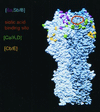Complement component C1q enhances the biological activity of influenza virus hemagglutinin-specific antibodies depending on their fine antigen specificity and heavy-chain isotype
- PMID: 11773411
- PMCID: PMC135831
- DOI: 10.1128/jvi.76.3.1369-1378.2002
Complement component C1q enhances the biological activity of influenza virus hemagglutinin-specific antibodies depending on their fine antigen specificity and heavy-chain isotype
Abstract
We have previously observed that selected influenza virus hemagglutinin (HA)-specific monoclonal antibodies (MAbs) with poor virus-neutralizing (VN) activity in vitro exhibited greatly enhanced VN activity in vivo after administration to SCID mice. The same Abs displayed improved VN activity also when tested in vitro in the presence of noninactivated serum from SCID mice. To identify Ab-dependent properties and serum components that contributed to enhancement of Ab activity, we screened a large panel of HA-specific MAbs for hemagglutination inhibition (HI) in the presence of noninactivated serum from naive mice (NMS). We found that HI activity was enhanced by NMS depending on the Ab's fine specificity (antigenic region Cb/E > Ca/A,D > Sa,Sb/B), its heavy-chain isotype (immunoglobulin G2 [IgG2] > IgG3; IgG1 and IgM negative), and to some extent also on its derivation (primary response > memory response). On average, the HI activity of Cb/E-specific MAbs of the IgG2 isotype isolated from the primary response was enhanced by 20-fold. VN activity was enhanced significantly but less strongly than HI activity. Enhancement (i) was destroyed by heat inactivation (30 min, 56 degrees C); (ii) did not require C3, the central complement component; (iii) was abolished by treatment of serum with anti-C1q; and (iv) could be reproduced with purified C1q, the binding moiety of C1, the first complement component. We believe that this is the first description of a direct C1q-mediated enhancement of antiviral Ab activities.
Figures







References
-
- Beebe, D. P., R. D. Schreiber, and N. R. Cooper. 1983. Neutralization of influenza virus by normal human sera: mechanisms involving antibody and complement. J. Immunol. 130:1317–1322. - PubMed
-
- Bindon, C. I., G. Hale, and H. Waldmann. 1988. Importance of antigen specificity for complement-mediated lysis by monoclonal antibodies. Eur. J. Immunol. 18:1507–1514. - PubMed
-
- Bizebard, T., B. Gigant, P. Rigolet, B. Rasmussen, O. Diat, P. Boeseccke, S. A. Wharton, J. J. Skehel, and M. Knossow. 1995. Structure of influenza virus haemagglutinin complexed with a neutralizing antibody. Nature 376:92–95. - PubMed
-
- Botto, M., C. Dell’Agnola, A. E. Bygrave, E. M. Thompson, H. T. Cook, F. Petry, M. Loos, P. P. Pandolfi, and M. J. Walport. 1998. Homozygous C1q deficiency causes glomerulonephritis associated with multiple apoptotic bodies. Nat. Genet. 19:56–59. - PubMed
-
- Brekke, O. H., T. E. Michaelsen, and I. Sandlie. 1995. The structural requirements for complement activation by IgG: does it hinge on the hinge. Immunol. Today 16:85–89. - PubMed
Publication types
MeSH terms
Substances
Grants and funding
LinkOut - more resources
Full Text Sources
Other Literature Sources
Miscellaneous

